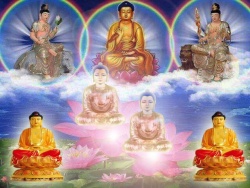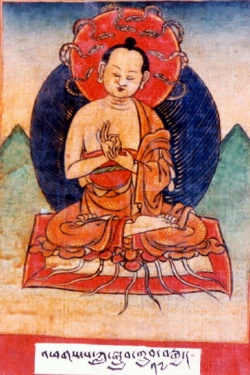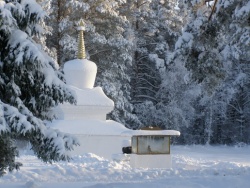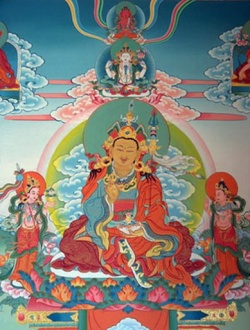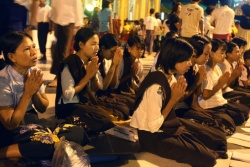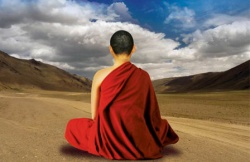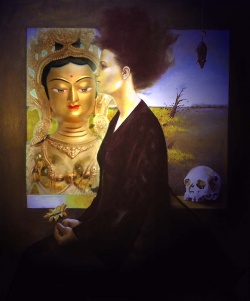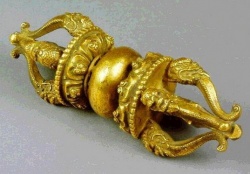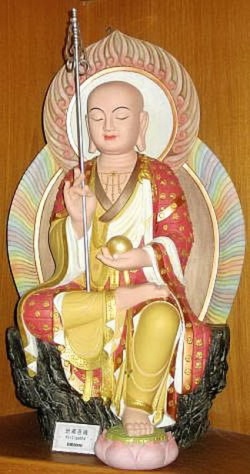The Names of Rivers (Sanskrit-Tibetan-Mongolian) by Natalia S. Yakhontova
All rivers in India were considered sacred. It is said that “the mighty rivers upon whose banks the civilizations were built receive special homage as the givers of Life and fertility.
These rivers are the veins and channels on the Body of Mother Earth, just as the mountans are her limbs, the forests are her Hair, and the cities and town scattered about the country her organs of sense.
The gairika or red sediment carried from the hills which periodically gives certain rivers a reddish hue is regarded as her menstrual flow.” [The Hindu World, 1968, vol. II, p. 303]. Most rivers are regarded female.
The holy triad of rivers is Ganges, Yamunā, Sarasvatī.
Seven sacred streams are these three with addition of Godāverī, Narmadā, Indus and Kāverī. Still there may be variations in the list.
The Sanskrit sources of the names of the rivers are
The first one - lexicons:
the famous Amarakośa dictionary composed by Amarasimha (8th century) and Abhihānacintāmani dictionary by Hemacandra (12th century).
Lexicons are special kinds of dictionaries which being examples of poetical pieces themselves aim to be a source of inspiration and a kind of poetical reference book for other poets.
They present epithets or sub-names for quite a number of persons and phenomena. Not only characters from mythology can have epithets but Animals, plants and natural phenomenon as well.
And some rivers.
Epithets are organised there according to subjects: that means that all epithets for one person are given as a list.
These epithets can be used as names (instead of common names) and sometimes the well-known name is not the first on the list of epithets.
In Amarakosha first comes
Gaïgā, then Yamunā, Narmadā, Kara-toyā, Bāhu-dā, Śata-dru, Vi-paśa and ŚoÂa.
Eight rivers.
In the other lexicon (Abhihānacintāmani by Hemachandra) there are 13 names of the rivers and a little bit more epithets per river.
These two dictionaries represent the Induist tradition.
On the other hand there is a Buddhist tradition: here, the Sanskrit source is “Abhidharmakośa” by Vasubandhu namely its third part Loka-nirdeśa “The Description of the World”.
There in the 57th karika (kārikā) it is said that behind nine mountains, and further behind Himavat mountains there is a lake called An-avatapta (not heated).
Four rivers flow from it. They are Gaïgā, Sindhu, Paksu (or Puksu), Sitā.
So this list is different from the Amarakosha one.
These both traditions were known in Tibetan.
There are three translations of Amarakośa dictionary into Tibetan.
As for the second tradition I can refer to any Tibetan dictionary (Das, Nitartha on-line, etc.) where four rivers (Gaïgā, Sindhu, Paksu Sitā) are called dag byed bzhi ‘four holy rivers’ or ‘four purifing rivers’.
And I’m going to show how these two traditions were combined in Tibetan lexicography, actually in one dictionary. And I can’t help mentioning some minor transformations made on the way of translation.
So the Amarakosha is for Sanskrit and Tibetan, The Decoration of the Wise Men’s Ears - for Tibetan (I’ll refer to it as “The Tibetan dictionary”) and occasionaly the Tibetan-Mongolian dictionary by Sumatiratna (late 19th century) for Mongolian examples.
The Tibetan dictionary under consideration is “The Decoration of Wise Men’s Ears” (its full title is mngon brjod kyi bstan bcos mkhas pa'i rna rgyan zhes bya ba bshugs so ). Tib. mngon brjod ‘synonim’ specifies the type of the dictionary.
It was composed by dga-dbang ’jig-rten dbang-phyug grags-pa’i rdo-rje in Tibetan in the 16th century following the Indian tradition of the Sanskrit lexicons and borrowing a lot from them (namely Amarakosha).
But at the same time it was influenced by Buddhism of Vajrayana (it begins from epithets for Vajra-dhara, Kalachakra, Hevajra). Some other Buddhist characters, for example, Maitreya, Avalokiteshvara, Manzhushri, Tara, are added as well. But the list of other referents follows that of the Amarakosha.
Now back to rivers.
First of all we’ll put the Gangga aside. Its name is the first among the rivers whatever list we take. Its epithets (Sanskrit-Tibetan-Mongolian and even Oirat) you can find in my book.
As for other rivers, that are really existing (or existed) rivers, we’ll follow the Amarakosha and start from Yamunā. In the Tibetan dictionary the first set of epithets is that of Yamuna (it is introduced as “the names of the Yamuna-river”), but at the end of the list the name Pakshu) is added with a commentary that it flows from the West. Not a trace of any Pakshu in AK.
So the first river - Yamunā . Yamunā is the modern Jamna, it flows from the Himalayas and is one of the main tributaries of Gannga. At the same time it is a goddess, she is the daughter of Sūrya and she is called
1. Skr. Sūrya-tanayā ‘the daughter of Surya’, Tib. nyi ma’i bu mo ‘the daughter of Sun’, Mong. naran-u ökin id. The referent in SR is Yamuna.
2. Skr. Kālindī ‘coming from Kalinda’, Tib. ka li nda’i bu mo ‘the daughter of Kalinda’ (Kalinda is the name of a mountan). The other translation of this Epithet is Tib. rtsod can ‘with quarell’, the reason for such translation is that Skr. kali means ‘quarell’.
The Tibetan dictionary (“Decoration of Wise Men’s Ears”) has an explanation that “the river is called so because many years ago people argued where this river flows to. Now we know that it flows to the Vindhya mountains”.
3. Another Epithet is Skr. tapana-sutā ‘the daughter of Sun’ (tapana ‘burning, causing pain’ is one of the Sun’s epithets), Tib. gdung byed ma ‘she, who causes Suffering’, Mong. enelgegči em-e ‘mother who causes Suffering’, which is far from the original meaning. The referent in SR is Yamuna.
4. Yamuna is a sister of Yama and she is called Skr. śamana-śvastÉ ‘a sister of Yama’, Tib. zhi ba’i sring mo ‘sister of a peaceful one’.
Skr. śamana has two meanings: “calming” and “destroying” and it is an Epithet of Yama.
It is translated with Tib. zhi ba which, as a separate word, is an Epithet of Buddha, Maheshvara, Uma and Tara, but not Yama.
The Tibetan commentary says that Yamuna is a sister of zhi ba, who is the one who made Yama flee (it might be any from the list, most probably Buddha) but it is not the original meaning of this Epithet.
The same Sanskrit Epithet is translated as Tib. gshin rje sring mo ‘Yama’s sister’ and as Mong. erlig-ün egeči ‘erlik’s sister’. And the name of the referent is Pakshu.
By the way, in the SR dictionary Yama’s epithed is Tib. ya mu na’i spun zla ‘the brother of Yamuna’, but its Mongolian translation is erlig-ün sadun ‘erlik’s relative’, which is incorrect.
The second river in AK is Narmada (Skr. narmadā lit. ‘causing pleasure’), it has several epithets.
Its epithets are properly translated into Tibetan in the Tibetan dictionary but the referent is not Narmada, but Sindhu (and in SR as well). In the Tib. dict. before the list there is a phrase “the names of the Sindhu river”.
The beginning of the list (first four names) in the Tib.dict. and in AK are the same:
1. Skr. narmadā, Tib. rtse ’dzo’i chu bo - ‘river causing pleasure’, Mong. naγadun kögerün mörün ‘river giving fun and Joy’.
It is a literal translation of the Sanskrit narmadā.
2. Skt. revā, Tib. rgyal ‘gro ‘victorious’
3. Skr. soma-udbhavā ‘sprung from the Moon’, Tib. zlas byung id.
4. Skr. mekala-kanyakā ‘Mekala’s daughter’, Tib. me ka la’i bu mo id.
The fifth name is borrowed from another Skr. lexicon:
5. Skr. pūrva-gaïgā ‘the Easten Gangga’, Tib. sngon gyi ga nggā ‘the ancient Gangga’, Mong. erten-ü γangγa id. One of the meanings of the Skr. word pūrva is “ancient” which was chosen for the translation.
And the next name is from AK, but there it refers to a different river:
6. Skr. bāhu-dā ‘giving a lot’, Tib. mang po byin id., Mong. olon-i öggügči id. The last name is the name of another river Arjuna, whose epithets are given in AK below. The Tibetan translator read bahu ‘a lot’ instead of bāhu ‘an arm’.
At the very end of the list there is the name Sindhu with a commentary saying that it flows from the West. But no any Sindhu in AK.
In AK after Narmada (or Sindhu according to the Tibetan dictionary) there are names of five rivers with their epithets but all of them are united as epithets of the Sita river in the Tibetan dictionary.
And the name Sita is the last on the list with the commentary that it flows from the north. No trace of Sita in AK.
1. River Karatoya Skr. kara-toyā ‘water from the hand’, Tib. lag pa’i chu bo id., SR mentions only the referent (Sita-river) without translation.
The legend has it, that it “Originated from the water poured into the hand of Shiva at his marriage with Parvati and thrown by him on the ground.” The same legend is repeated in a Tibetan commentary in the Tib.dict.
The other way of rendering this name in Tibetan is lag chu ‘water-hand’. SR also has this version but without Mongolian translation and the referent is wrong - the Ganga river.
2. The other name of Karatoya is Skr. sadā-nīrā ‘eternal water’, Tib. rtag ’bab id. The Tib.dict. gives a comment that “there is a constant flow of red powder like menstrual blood”.
3. River Arjuni Skr. arjunī, lit. ‘white’, Tib. srid sgrub ma ‘establishing existence’, Mong. törö-yi bütügegči ‘one who establishes Power ’, jayaγa-ni bütügegči ‘one who establishes fate’.
4. Another name of Arjuni is Skr. bāhu-dā lit. ‘a giving arm’, Tib. dpung pa byin id. The same Skt. bāhu-dā was translated as Tib. dbyig gi dpung pa ‘an arm of wealth’, Mong. erdeni-yin ömög ‘a precious army’. (Tib. dpung has both meanings “arm” and “army”).
The translators tried to make this name sound better. In the list of names in the Dict. by Das there is dbyig gi khu ba ‘сок богатства’. Tib. Khu ba resembles Tib. dpung ba and the meaning suites the name of river much better.
5. The third name of Arjuni is Skr. saitavāhinī, Tib. dkar ’bab ‘a white flow’ (Skr. sita ‘white’, vāhin ‘going’).
6. River Vipasha Skr. vi-pāśa ‘having no noose’, Tib. zhags grol ‘freeing noose’.
There is a legend according to which this river freed the noose tied around the neck of rishi Vasishtha when he was going to commit a suicide.
In the SR’s dictionary the Tibetan version was a little bit transformed: Tib. zhag sa grol ‘a free place for a night rest’, Mong. translation is γajar getelkü ‘freeing the land’. Rather far from the original meaning.
7. River Shatadru Skr. śata-dru ‘flowing in a hundred streams’, Tib. brgyar gyes id. Mong. olan salburatu ‘with many parts’.
It is the modern Sutlej. The legend has it that rishi Vasishtha decided to commit a suicide (again, on a different occasion) tied a stone to his belly and threw himself into the river, the latter being afraid of his Power devided its stream into a hundred smaller ones.
This legend is reproduced in the Tib.dict. as well.
There are two other epithets of this river Skr. śita-dru and Skr. śutudrī which are not included into the Tib.dict.
8. River Shona Skr. śoÂa lit. ‘red’. Tib. khrag ‘bab ‘blood flow’, Mong. čisun-iyar urusuγči id.
There is one more Epithet of the Shona river Skr. hiraÂya-vāha ‘carrying gold’, Tib. gser lag ‘a golden hand’ is not included into the Tib.dict.
So these eight names of 5 rivers from AK are mixed up in the Tib.dict. (their order is different from that of AK) and presented as the names or epithets of the river Sita.
That means that using the names of rivers from AK the author of the Tib.dict. made them fit into four rivers of the Buddhist cosmological tradition preserving their legends from the Hinduism.
The author of the Tib.-Mong.dict. Sumatiratna followed mostly the Tibetan dict. only adding some false info.


